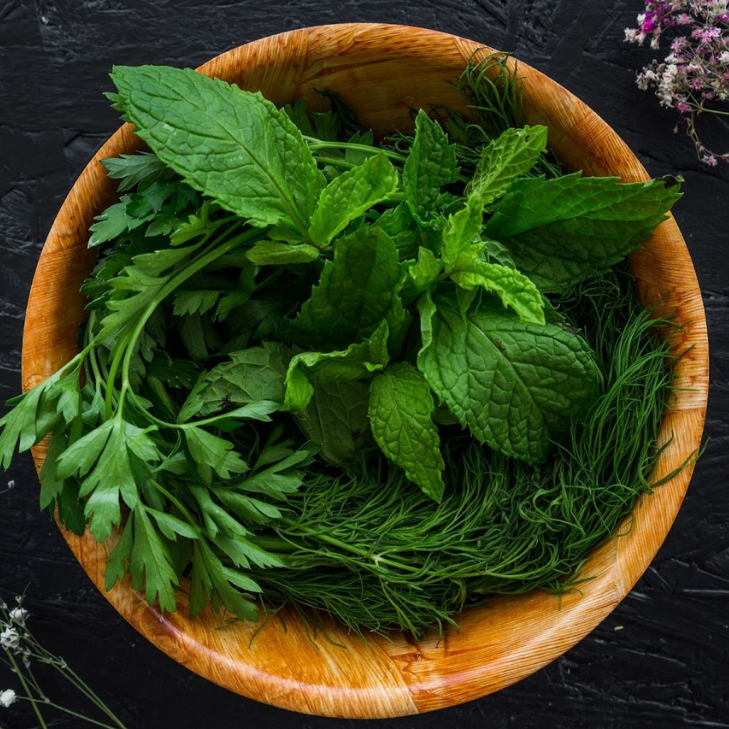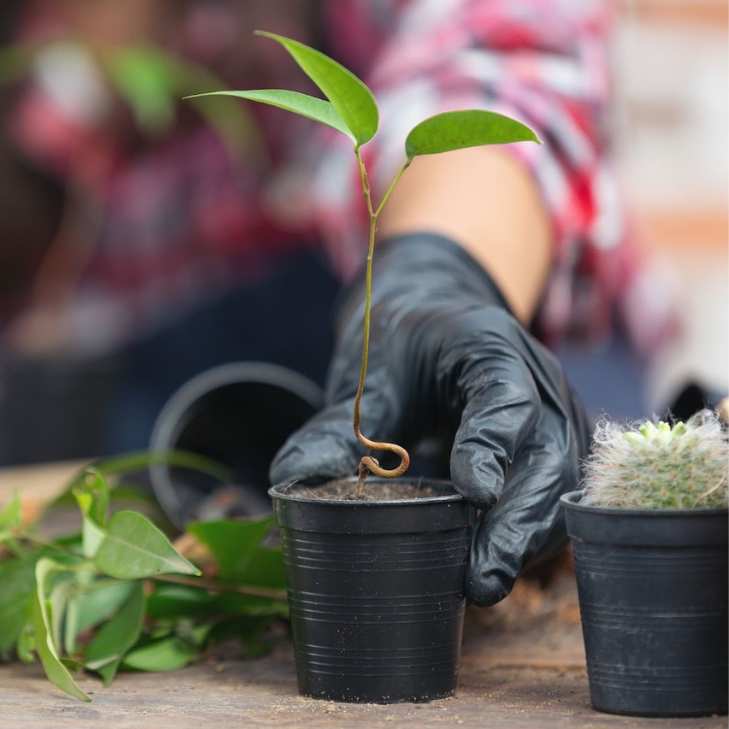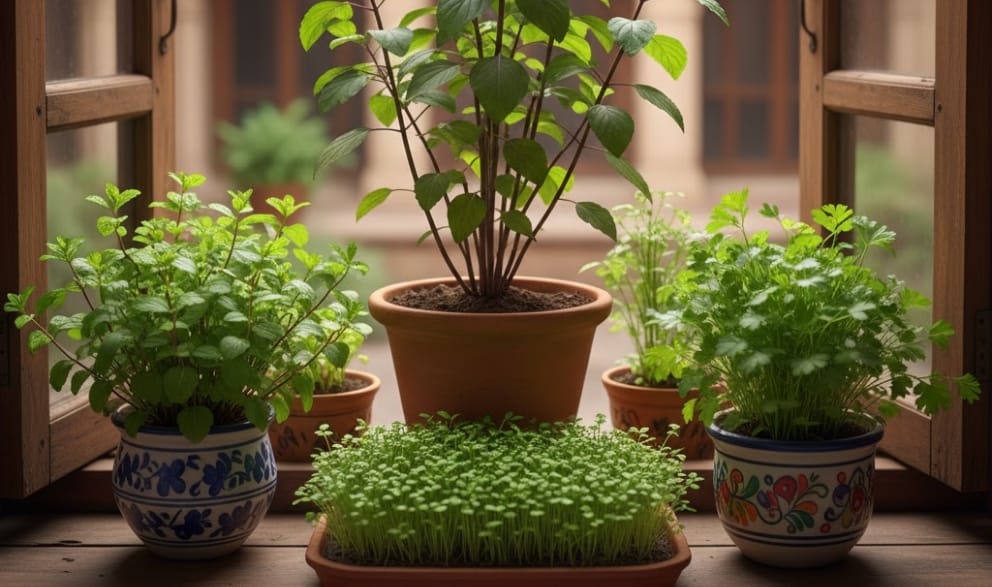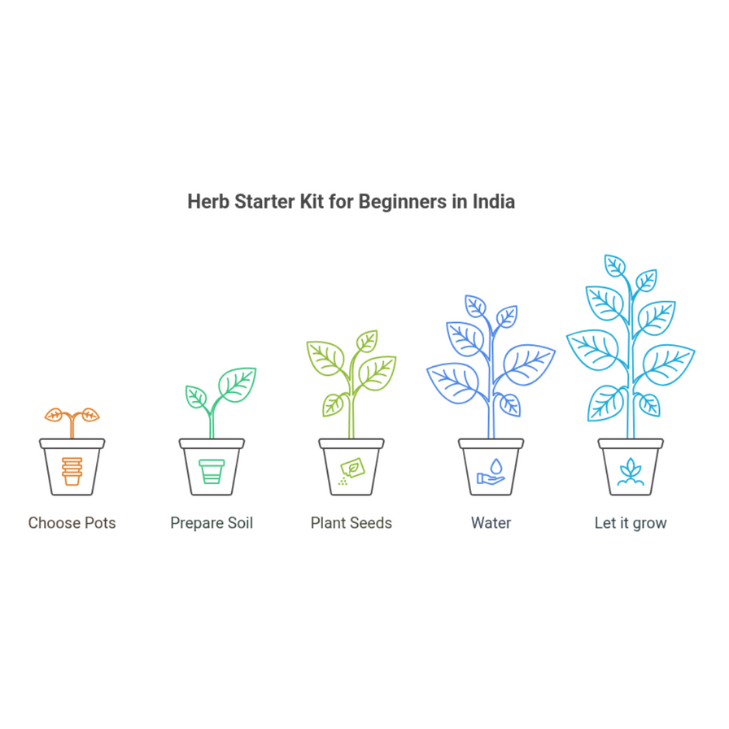Fresh herbs at home are easier than you think. Let’s grow a little green magic in your space.
|
What you’ll learn in this blog:
|

You know that feeling when you buy a bunch of coriander, use it once, and then find it sad and drooping in the fridge two days later? We have all been there. At some point, you probably wondered if it is really possible to grow herbs at home and stop wasting money on wilted greens. The good news is that you absolutely can.
According to the Indian Council of Agricultural Research (ICAR), most kitchen herbs thrive between 20°C and 30°C, making Indian climates ideal for balcony and terrace gardening.
Growing herbs at home in India is one of the easiest and most rewarding hobbies you can pick up. This guide will walk you through the best herbs to grow in Indian conditions.
Why Should You Grow Herbs At Home In India?
People usually start growing herbs because they want fresher flavours in their food, but what they discover along the way is how much more connected it makes them feel to what they eat.
Homegrown kitchen herbs are richer in aroma and taste, and they do not contain the pesticides that often come with commercially grown produce. You save money, too, since most herbs keep giving new leaves for months once established.
They also add oxygen and greenery to your space, which can do wonders for your mood. Many herbs are also used in Ayurveda for improving immunity, reducing stress, and balancing digestion.
Which Herbs Grow Best At Home In Indian Conditions?
The secret to growing herbs in the house successfully in India is choosing the ones that enjoy our warm, often humid weather.
Whether you live in a Mumbai apartment with a tiny balcony or a spacious home in Bangalore with morning sunlight pouring in, you can build a herb corner that keeps your kitchen stocked with fresh greens all year round.
Here is a quick guide to the most reliable culinary herbs you can grow easily at home.
| Herb | Indian Name | Ideal Growing Season | Light Requirement | Water Needs | Growing Tip |
|---|---|---|---|---|---|
| Tulsi | Holy Basil | Year round | Full sunlight | Moderate, regular watering | Pinch leaves often to encourage branching |
| Mint | Pudina | All seasons | Full to partial sunlight | Keep soil moist | Plant separately; spreads fast |
| Coriander | Dhania | Sept to Feb | Partial sunlight | Keep soil moist | Crush seeds before sowing |
| Curry Leaf | Kadi Patta | Warm months | Bright sunlight | Water every alternate day | Prune regularly |
| Fenugreek | Methi | Winter | Partial sunlight | Moderate watering | Ready to harvest in 3 weeks |
| Dill | Sowa | Winter | Full sunlight | Light watering | Avoid soggy soil |
Even if you are a complete beginner, you can start with coriander or mint and see visible results in a few weeks in your indoor herb garden.
If you’re curious about healing plants too, we’ve also put together a simple blog on herbs, medicinal plants, and vegetables that you can grow right at home.
How to Take Care of Herbs at Home in India?

Herbs are not decorative plants. They are functional living ingredients, and that means they need thoughtful care. Let us go step by step so you can build good habits early.
- Choosing pots wisely: Always pick pots with holes at the bottom for drainage. Herbs dislike waterlogged soil. Terracotta pots are perfect because they allow air to flow through the soil and keep roots healthy.
- Using quality soil: Use light, well-draining potting mix instead of regular garden mud. A blend of compost, cocopeat, and garden soil works beautifully because it keeps moisture balanced without becoming sticky.
- Watering schedule: Water only when the top inch of soil feels dry. Herbs prefer steady moisture but not standing water.
- Sunlight balance: Tulsi, mint, and curry leaf love direct sunlight. Coriander, methi, and dill prefer a little shade or morning sun. If your balcony faces east, you will get perfect light for most mini herbs.
- Harvesting correctly: Regular trimming encourages new growth. Do not hesitate to pick leaves every few days. It keeps the plant healthy and gives you a steady supply.
When Is The Best Time To Start An Herb Garden In India?
The right time to start depends on where you live. If you are in northern or central India, start planting herbs around September. The weather cools down enough for coriander and fenugreek to flourish. For southern states, you can plant almost all year round, though December to February is ideal because of mild temperatures.
During monsoon months, make sure your pots have excellent drainage since excess rainwater can cause fungal infections. In very hot summers, shift pots slightly away from the direct afternoon sun.
If you’d rather skip the hunt, you can always shop for everything you need for your herb corner right here and start growing today.
How Can You Grow Herbs Indoors In India?
Even if you live in a flat with limited sunlight, you can still grow herbs indoors successfully.
- Pick varieties that adapt well indoors, such as mint, tulsi, coriander, curry leaf, and fenugreek.
- Place your pots near a bright window that gets gentle morning light.
- South or east-facing windows are ideal.
- If your space feels too dim, you can use reflective surfaces or mirrors to bounce light towards your plants.
- Make sure there is enough air circulation between pots to avoid mould.
- Water sparingly and add a little compost every few weeks.
Which Herbs Should Not Be Planted Together?
Some herbs simply do not get along. Their root systems or natural compounds interfere with each other’s growth.
- Keep mint separate since it spreads fast and crowds out neighbours.
- Fennel should also be grown alone because it releases chemicals that can slow down nearby plants.
- Dill attracts certain insects that are harmful to Mediterranean herbs like rosemary or sage, so keep them apart.
Grouping kitchen herbs with similar needs is a smart strategy. For instance, coriander, methi, and dill like moderate moisture, while rosemary, thyme, and sage prefer drier soil.
FAQs
What is the easiest herb to grow at home in India for starters?
If you are starting out, the best herbs to grow at home are Tulsi, Mint, and Coriander. They are easy to maintain, grow quickly, and give you visible results within weeks.
How long does it take for herbs to start giving harvestable leaves?
Most herbs, such as coriander, mint, and methi, begin producing usable leaves within three to four weeks. Slower ones like curry leaf take a little longer, but once established, they continue to provide fresh leaves for years.
How can I keep pests away naturally?
Mix a little neem oil with water and spray it on the leaves every two weeks. It keeps aphids and whiteflies away without harming the plant.
Can I use kitchen waste as compost for herbs?
Yes, you can. Vegetable peels, tea leaves, and eggshells make great compost when properly decomposed. Just avoid oily or salty food waste, as it can attract pests.
What is the king of all herbs?
Tulsi, also known as Holy Basil, proudly holds the title of the king of all medicinal herbs to grow at home in India. It is part of daily life, worship, and wellness. In Ayurveda, Tulsi is considered an adaptogen that helps the body manage stress, boosts immunity, and supports respiratory health.
Can I start an herb garden in September?
Yes, September is one of the best months to begin your herb garden in most parts of India. As the monsoon tapers off and the weather turns cooler, herbs like Coriander, Fenugreek, and Dill sprout beautifully without the risk of drying out.
What is the most expensive Indian herb?
The most expensive Indian herb is Saffron, known locally as Kesar. This golden treasure can cost thousands of pounds per kilo because producing even a small amount requires painstaking manual labour. It takes around 150,000 crocus flowers to yield just one kilogram of dried saffron threads.
Which herbs grow well indoors?
Coriander, Mint, Tulsi, Fenugreek, and Curry Leaf all adapt nicely to windowsill or balcony conditions. Just make sure they get at least a few hours of indirect sunlight each day.



